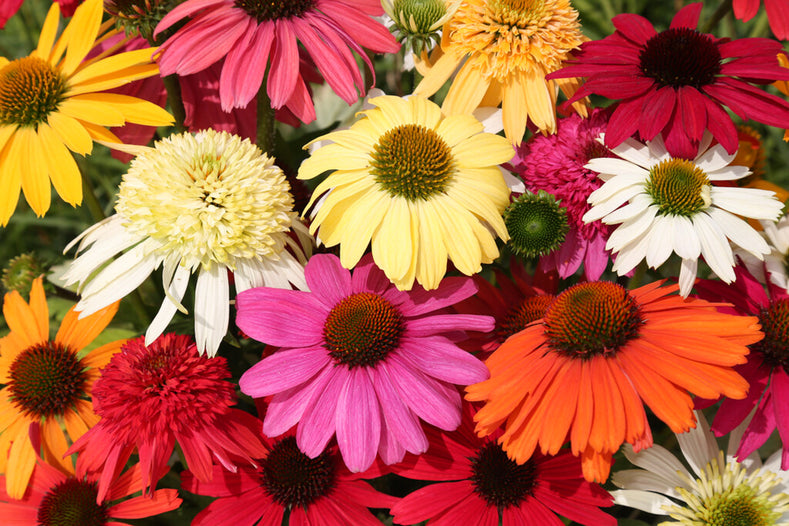Echinacea, also known as “coneflowers” and part of the daisy family, is a popular perennial for midsummer blooms. Do you want to grow echinacea flowers yourself? Learn how to plant them the right way and get more caring tips in this blog post.
Quick guide:
- Planting season: Spring
- Place: Full sun
- Soil: Well-drained soil
- Water: Drought tolerant, but new plants need water occasionally
- Fertilizer: Fertilizer is rarely needed
- Mulch: Thin layers of compost, then mulch on top of the soil surface
- After blooming: Cut back stems to soil level once they wither or after the first frost
Echinacea: A Popular Wildflower In The United States
Echinacea is a popular wildflower native to the eastern and central United States, extending from Colorado south to Texas and north to the Great Lakes. The flowers bloom from midsummer all the way through fall frost. Coneflower plants are perfect for a wildflower meadow that attracts butterflies and bees, or are suitable as cut flowers in a vase.
Did you know that the pale purple coneflower (echinacea purpurea) with its narrow petals is the most common and readily available variety of this striking plant?

Our Best Tips For Growing Echinacea
1. Planting Echinacea
Echinacea prefers full sun and well-draining soil. The flowers are drought-tolerant and can grow in poor soil, but the results may vary. With the following steps, you will plant coneflowers successfully:
- Dig a hole and set the plant so that its root ball is level with the soil surface.
- Fill with soil into the top of the root ball, space plants one to three feet apart depending on size at maturity, and water thoroughly.
- Spread thin layers of compost, then mulch on top of the soil surface to help keep plants moist, establish roots, and prevent weeds.
2. Growing Echinacea
Echinacea is drought tolerant, but new plants need water occasionally and more often if spring is especially dry. The flowers seldom need fertilizer. To delay blooming until fall and promote compact growth, you can cut back the stems by about a foot when the plants start blooming. For staggered bloom heights and times, cut only a few stems.
3. Echinacea Care After Blooming
In colder areas, spread some light mulch during late fall to help protect the roots from winter damage. Cut back stems to soil level once they wither or after the first frost. This will help promote healthy new growth in spring. If you wish to divide or transplant coneflowers, you can do so in spring or fall.
Learn more: How to Grow Coneflowers (Echinacea)?
Growing Coneflowers In Pots
A coneflower is often planted in the ground as a hardy perennial. However, they can be grown in containers as long as the pot is large enough to accommodate their taproot.
Good to know: DutchGrown does not sell potted plants. The following steps will help you plant Echinacea in pots:
- Use containers of 2–3 gallons or larger size with drainage holes. Line the bottom of the pots with broken stones for drainage.
- Securely fill the container halfway with potting soil and tamp it down.
- Plant the root system an inch beneath the edge of the holder, spreading out its roots.
- Add in dirt slowly until flush with the top layer of the root ball, then compress slightly.
- Douse copiously at ground level when the soil is dry to the touch.
Echinacea Care For Plants In Pots
After you have successfully planted the roots in pots, it is important to take care of your echinacea plants. Even after they have finished flowering to encourage new flowering in the next growing season. Use the following tips:
- Fertilize every few weeks using a water-soluble 10-10-10 element.
- For sustained blooming, cut off flowers nearer to their base. When plant development eases off in fall weather, trim plants down to the soil level to endure wintertime.
- Transfer to a chilly (40º - 50ºF) region that has nominal light to partial shade.
- Inspect the soil each couple of weeks and lightly water when the top three inches are dry.
- As new growth appears in the spring, move it to a brighter, warmer area (60º - 70ºF), as this will help prepare it for outdoor living during the spring and summer seasons.
- Avoid irrigating foliage from above as it can induce fungal growth on leaves; instead, try drenching at soil plane level.
- Utilize an insecticidal soap, or neem oil solution spray if any aphids or bugs turn up.
- Every 3 to 4 years in spring, once new growth commences, segment and rehome echinacea crops.
Choose Your Favorite Echinacea Bare-Roots at DutchGrown
At DutchGrown, you will find several varieties of Echinacea bare roots that sprout beautiful flowers. From pink to yellow, multicolored or a mix. And from a mid-sized to a narrow-leaf coneflower. Our bare-roots come from Holland, and we ship them all over America. Browse our collection of Echinacea bare roots and choose your favorites for your garden. We will ship the roots in spring.

Frequently Asked Questions About Echinacea Plants
Is Deadheading Echinacea Necessary?
Deadheading coneflowers are a matter of preference. If you deadhead right after the flower fades, you prolong blooming and prevent reseeding. However, if you can wait until late winter, your bird visitors, especially goldfinch, will enjoy those seed heads. Echinacea is well known for self-seeding, so if you keep them welcoming to pollinators, you'll have them blooming in multiple places in the garden to attract butterflies and bees.
Does Echinacea Spread?
Echinacea is not an aggressive plant, but it will naturally self-seed and spread, which you can encourage if you wait to cut back until late winter. If you prefer to prevent this, simply deadhead the flowers right after they fade. Keep in mind that hybrid varieties will not self-sow as most are sterile, which means they do not produce viable seeds.

